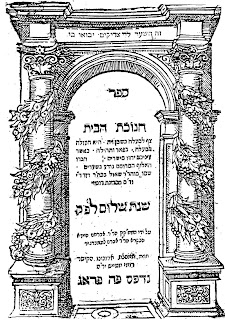A Forgotten Work on Chanukah: חנוכת הבית
Rabbi Eliezer Brodt of Jerusalem has authored articles in the journals Ohr Yisrael and Yeshurun, both familiar to many readers of the Seforim blog, and is contributing what is hoped to be the first of many guest-posts.
While learning הלכות חנוכה, I noticed that the very first מגן אברהם quotes a sefer called חנוכת הבית. I had never heard of the sefer before, and I was curious about it. I asked several people about the sefer until I found someone who was familiar with it. He was kind enough to purchase it for me. I started reading through the sefer last week, and I completed it over shabbos. It was a fascinating read.
In the introduction, the author begins with a list of questions about the נוסח of הנרות הללו. He then proceeds to answer his questions with the interesting concept that almost all of the הלכות חנוכה are hidden in the text of הנרות הללו. I believe that this is a virtually unknown idea, as I have yet to see this concept quoted in any sefer about חנוכה — including the outstanding sefer חזון עובדיה by ר’ עובדיה יוסף. Even the generally exhaustive מפתח על שבתי פרנקל on מסכת בבא קמא in the גמרא relating to חנוכה he makes no mention of his piece on this גמרא!
Not much is known about ר’ שאול בן ר’ דוד, the author of חנוכת הבית. His date of birth appears to have been around the year 1570. We do know that he learned from the מהרש”ל השני and ר’ הירש שור, the father of the תורת חיים. He was a ראש ישיבה in Russia. ר’ שאול wrote a few seforim, the most well known being טל אורות on the ל”ט מלאכות of שבת. The טל אורות received many very חשוב הסכמות, including הסכמות from the מהרש”א, the כלי יקר and the של”ה. It’s quoted by the מגן אברהם and מרכבת המשנה many times. A beautiful edition was reprinted in ירושלים in 1996. Another sefer by this author is תפלת הדרך which was printed by his son in 1641 [this book includes an unusual illustration of a ship at sea on the last page]. The sefer חנוכת הבית was first printed in פראג in 1616. It was not reprinted until in 1981 in a photo offset version. It was reprinted a year later, and in 2002, a very nice edition with notes was printed.
חנוכת הבית seems to be almost completely unknown to many bibliographers. The חיד”א makes no mention of it in his שם הגדולים although he has two entries on the author. The bibliographer יצחק בן יעקב has two separate entries on the sefer, one of which says “this might be the sefer that the מגן אברהם quotes a few times,” but he doesn’t write any details about it. Then two entries later he talks about our sefer showing he never saw it – because it’s the same one that the מגן אברהם mentions.
As previously mentioned, חנוכת הבית starts with the concept that almost all of הלכות חנוכה are hidden in הנרות הללו. There are three additional parts to the sefer. The first is a song which contains many of the halachos of חנוכה in the lyrics. Another part is מליצות based on הלכות חנוכה containing clever גמטריות and kabbalistic ideas about חנוכה. The third part is a דרשה connecting פרשת תצוה to חנוכה in many ways. The author was fond of writing in song. He also wrote similar kinds of songs in his work ט”ל אורות. In his introduction to ט”ל אורות, he writes that he likes this method because it’s a great memory tool. We have other songs he composed, such as a song in the שלשלת הקבלה, which was a הספד on his רבי, the מהרש”ל השני. Another song he wrote could be found in one of the manuscript’s of סידור שבתי סופר, which was written by his nephew.
חנוכת הבית discusses almost all the important topics related to חנוכה and makes many interesting points. The author goes through many of the גמרות in מסכת שבת about חנוכה at great length. He deals with topics such as the famous question of the בית יוסף. (See סקווירא תשסג p. 33), why חנוכה isn’t nine days because of ספיקא דיומא (Idem at p. 50), why the מנורה wasn’t טמא etc (Idem at p. 36). He takes sides on some of the big halachick questions in the פוסקים such as whether to light נר שבת or נר חנוכה first (Idem at p. 58), whether to make הבדלה before נר חנוכה on מוציא שבת or not (Idem at p. 60), and many other topics. The author also takes a stance in the big controversy about the נוסח of the ברכות. Like the מהרש”ל, he says that the correct way is to say שלחנוכה as one word (Idem at p. 32). The sefer mentions that the מהר”י סגל lit נרות in the place where he gave his שיעור (Idem at p. 120). Also mentioned is the reason for the מנהג to eat milchigs on חנוכה (Idem at p. 136). חנוכת הבית is also the earliest known source for giving gifts on חנוכה. In his song, the author uses the words “לחלק מתנות.” In the הלכה part of the sefer, he writes that one should give צדקה, especially to the children who are learning תורה (Idem at p. 72, 83). It is this statement the מגן אברהם quotes when he quotes from the חנוכת הבית. The חנוכת הבית is quoted another time by the מגן אברהם in הלכות פסח.

